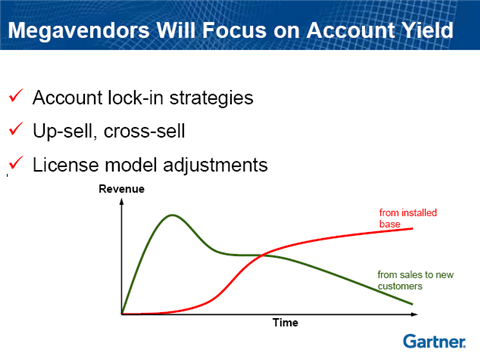Are software megavendors too big to stumble?

There's a good chance you get most--if not all of your software--from four massive companies: IBM, Microsoft, SAP and Oracle. And their game is simple: Grab more of your so-called wallet share.
The big question is whether these vendors are so massive that they can do no wrong or whether they'll collapse under their own weight. It's not hard to find folks that argue that latter, but the reality is quite different--these hulking software companies can raise your maintenance fees with the greatest of ease.
Those are some of the thoughts bouncing around in my head as Gartner analysts Yvonne Genovese and Jeff Comport present their take on megavendors at the Gartner Symposium and ITxpo in Orlando.
In the grand scheme of thing, these vendors are essentially growing by gaining more share among existing customers. They aren't luring new ones per se. In sum, Genovese and Comport note:
In a strange contradiction, we see rapidly changing technology in an industry that seems to be maturing. Vendors are focusing more on the “business of software”, rather than solely on product competition. Users faced with increased vendor power and lower price flexibility are looking for alternatives, containment strategies and ways to lower vendor switch costs. How the vendors react to these changes and pressures will be the basis for changes in their competition over the next five years.
It's hard to argue with that. But what's going to break? Customers have little clout. The business of software is just swell--both SAP and Oracle have raised maintenance fees. And Oracle is confident its margins will be strong no matter what the economy does. Alternate delivery models? Perhaps, but we aren't there yet.
Among the trends highlighted by Gartner:
- The sustainability of profit margin growth is under attack from many directions (SaaS, new models, buyer relationships).
- Megavendors keep adding to their stack of stuff. These moves are really about "installed-base harvesting" and adding more products to cross sell.
- Software giants must offer alternate delivery models. Software and IT will be delivered as a service and the downturn may accelerate the swap. How software giants navigate this sea change will make or break them. I buy this argument to a degree, but the disruption will take time to develop.
- Power is going to the user. Consumerization, multiple devices and Web 2.0-ish features are unavoidable. Ultimately software giants will have to cater to these digital natives who demand their personal life user interface at work. I'm lukewarm on this one. User interface clearly matters, but anyone that has seen real enterprise applications knows that the consumerization movement will take a long time to develop--if it develops at all.
So what's a megavendor to do? Lock you in.
Obviously Gartner's chart shows that there could be a trainwreck ahead. At some point, software giants won't be able to milk any more money out of existing customers. However, the big unknown is timing--it's telling that Gartner doesn't have specific years on its time axis. How soon will disruptive models put a dent into these massive software vendors?
